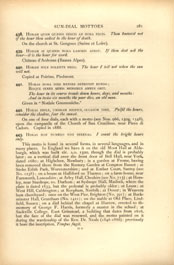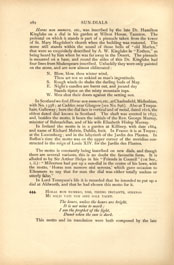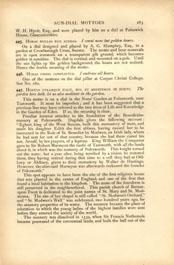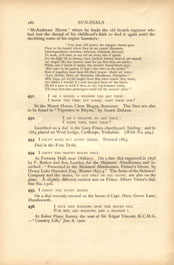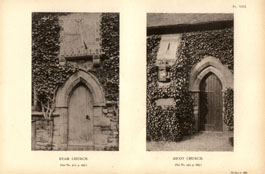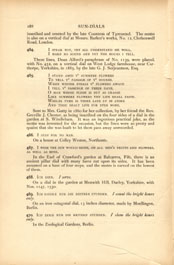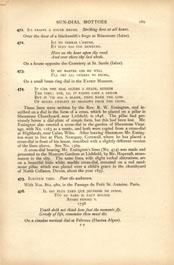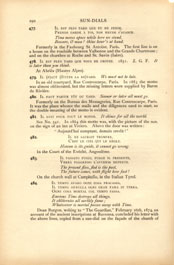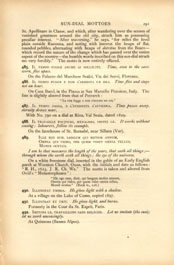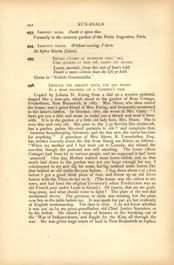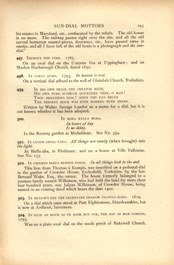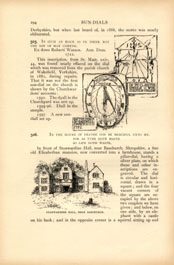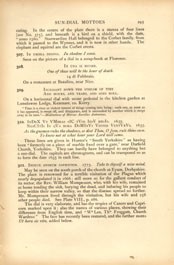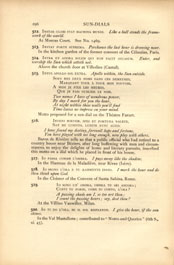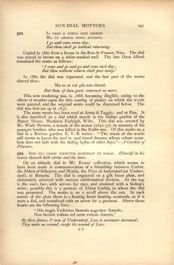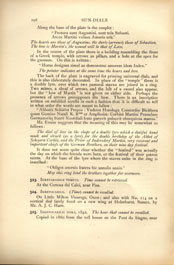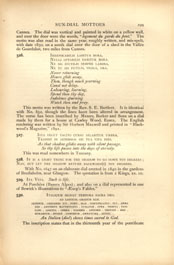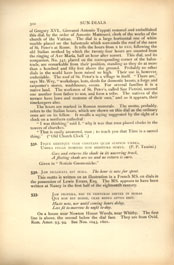Sun-Dial Mottoes (continued.)
| 438. | HORAM QUAM QUÆRIS NESCIS AN HORA NECIS. Thou knowest not if the hour thou seekest be the hour of death. On the church at St. Gengoux (Saône et Loire). |
| 439. | HORAM SI QUÆRIS HORA LABORIS ADEST. If thou dost ask the hour – it is the hour for work. Château d'Ardenne (Basses Alpes). |
| 440. | HORAM SOLE NOLENTE NEGO. The hour I tell not when the sun will not. Copied at Poirino, Piedmont. |
| 441. |
HORAS HORA DIES MENSES DETRUDIT EUNDO; Given in "Notizie Gnomoniche." |
| 442. | HORAS IMPLE, UMBRAM RESPICE, OCCASUM TIME. Fulfil the hours, consider the shadow, fear the sunset. On one of four dials, each with a motto (see Nos. 966, 1504, 1548), upon the campanile of the Church of San Crocifisso, near Pieve di Cadore. Copied in 1888. |
| 443. | HORAS NON NUMERO NISI SERENAS. I count the bright hours only. This motto is found in several forms, in several languages, and in many places. In England we have it on the old Moot Hall at Aldeburgh, which was built cir. A.D. 1500, though the dial is probably later; on a vertical dial over the front door of Bell Hall, near York, dated 1680; at Highclere, Newbury; in a garden at Frome, having been removed there from the Rectory Garden at Compton Basset; at Stoke Edith Park, Worcestershire; and at Ember Court, Surrey (see No. 1238); on a house at Halliford on Thames; on a farm-house, near Farnworth, Lancashire; at Arley Hall, Cheshire (see No. 715); at Horsley, near Stanhope, co. Durham; at Sydnope Hall, Matlock, where the plate is dated 1833, but the pedestal is probably older; at Leam; at West Hill, Cubbington; at Reepham, Norfolk; at Dover; in Weavereham churchyard, once on the West Pier, Brighton (No. 391); at Buckminster Hall, Grantham (No. 1421); on the stable at Old Place, Lindfield, Sussex; on a dial behind the chapel at Harrow, erected to th- memory of George F. Harris, formerly a master in the school; at Sackville College, East Grinstead, a building that dates from 1616, but the face of the dial was renewed, and the motto painted on it during the wardenship of the Rev. Dr. Neale (1846-1866): previously it bore the inscription, Tempus fugit. |
Horas non numero, etc., was inscribed by the late Dr. Hamilton Kinglake on a dial in his garden at Wilton House, Taunton. The pedestal on which it stands is part of a pinnacle taken from the tower of St. Mary Magdalen's church when the building was restored. The stone still stands within the sound of those bells of "old Marlen," that were so exquisitely described by A. W. Kinglake in "Eothen," as being heard by him when he was far away in the Desert. The pinnacle is mounted on a base, and round the sides of this Dr. Kinglake had four lines from Shakespeare inscribed. Unluckily they were only painted on the stone, and are now almost obliterated;
In Scotland we find Horas non numero, etc., at Charlesfield, Midlothian, with No. 1358; at Cadder, near Glasgow (see No. 896). Also at Troquahain, Galloway; here the dial face is vertical and of metal, dated 1616, the oldest dated dial known in Scotland. The shaft was erected in 1855, and, besides the motto, it bears the initials of the Rev. George Murray, minister of Balmaclellan, and of his wife Elizabeth Hislop Murray. In Ireland the motto is in a garden at Killiney, with date 1864, and the name of Richard Melvin, Dublin, fecit. In France it is at Troyes; at the Luxemburg; and in the labyrinth of the Jardin des Plantes. In Buffon's time the motto was on the upper corner of the meridian constructed in the reign of Louis XIV. for the Jardin des Plantes. The motto is constantly being inscribed on new dials, and though there are several variants, this is no doubt the favourite form. It is alluded to by Sir Arthur Helps in his "Friends in Council" (Ist Ser., I, ii.): "Milverton had put up a sun-dial in the centre of his lawn, with the motto, 'Horas non numero nisi serenas,' which gave occasion to Ellesmere to say that for man the dial was either totally useless or utterly false." In Lord Tennyson's life it is recorded that he intended to put up a dial at Aldworth, and that he had chosen this motto for it. |
|||||||||
| 444. |
HORAS NON NUMERO, NISI, PHŒBO INSTANTE, SERENAS The hours, unless the hours are bright, This motto and its translation were both composed by the late |
| W. H. Hyett, Esq., and were placed by him on a dial at Painswick House, Gloucestershire. | |
| 445. | HORAS NULLAS NISI AUREAS. I count none but golden hours. On a dial designed and placed by A. G. Humphry, Esq., in a garden at Crowborough Cross, Sussex. The motto and hour numerals are in open ironwork on a transparent gilt ground, which becomes golden in sunshine. The dial is vertical, and mounted on a pole. Until the sun lights up the golden background, the hours are not noticed. Hence the double meaning of the motto. |
| 446. | HORAS OMNES COMPLECTOR. I embrace all hours. One of the mottoes on the dial pillar at Corpus Christi College. See No. 280. |
| 447. | HORTUS UTRAMQUE TULIT, NOS ET MEDITEMUR IN HORTO. The garden bore both, let us also meditate in the garden. This motto is on a dial in the Nuns'Garden at Polesworth, near Tamworth. It must be imperfect; and it has been suggested that a previous line may have referred to the two trees of Life and Knowledge in the Garden of Eden. If so, the meaning is clear. Peculiar interest attaches to the foundation of the Benedictine nunnery at Polesworth. Dugdale gives the following account: "Egbert, king of the West Saxons, built this monastery of nuns, and made his daughter Edith the first abbess, having caused her to be instructed in the Rule of St. Benedict by Modwen, an Irish lady, whom he had sent for out of that country, because she had there cured his son Arnulf, by her prayers, of a leprosy. King William the Conqueror gave to Sir Robert Marmyon the castle of Tamworth, with all the lands about it, in which was the nunnery of Polesworth. This knight turned out the nuns; but a year after, being terrified by a vision, he restored them, they having retired during that time to a cell they had at Oldbury or Aldbury, given to their monastery by Walter de Hastings. However, the aforesaid Marmyon was afterwards reckoned the founder of Polesworth." This spot appears to have been the site of the first religious house that was planted in the centre of England, and one of the first that found a local habitation in the kingdom. The name of the foundress is still preserved in the neighbourhood. This parish church of Burton-upon-Trent is dedicated to the joint names of St. Mary and St. Modwenna. The site of her chapel is still called "St. Modwen's Orchard," and "St. Modwen's Well" was celebrated, two hundred years ago, for the sanatory properties of its water. The nunnery became the place of education to which the young ladies of the highest families were sent before they entered the society of the world. The nunnery was dissolved in 1539, when Sir Francis Nethersole became possessed of the conventual lands, and built the hall out of the |
ruins of the nunnery. It is supposed that the dial was then erected in the centre of a square garden on the site of the cloisters. It is now placed on the corner of an old wall, as if to get it out of the way. The garden has disappeared, but the spot is still an orchard with a pretty green sloping to the river side. As to the construction of the dial: there is a projecting base surmounted by several courses of wall stone on which is the principal object. This consists of a curved pediment of stone, supporting a square block, on the east side of which is represented a tomb; below is the motto, and on a scroll above are the words, "Non est hic: resurrexit" – He is not here: he is risen. The top is finished off so as to correspond with the pediment, and contains the Nethersole coat of arms. Among the devices are the Death's head and cross bones: also an apple, which seems to identify the reference in the motto with –
|
||||
| 448. | HORULA DUM QUOTA SIT QUÆRITUR HORA FUGIT. While one asks what the little hour is, the hour flies by. On a dial plate which was found in 1889 on a shelf in a cottage in Kirk Arbory, Isle of Man. It had, at some unknown date, been taken from the churchyard, where the pedestal still stood, and where, it is hoped, the dial has ere now been replaced. The motto was formerly on a dial in Rushen churchyard, but the present one, dated 1829, bears no inscription. |
|||
| 448*. | HOW LONG IS TIME? ASK THOU OF ME: On a wooden dial attached to the wall of an old house in the village of Lumbutts, among the hills near Todmorden. |
|||
| 449. | HOW WE GO On a dial at Woodville, Leicestershire, belonging (in 1889) to John Shefford, Esq. The motto was devised by Rev. E. Z. Lyttel, vicar of Woodville. |
|||
| 450. | I ALSO AM UNDER AUTHORITY. This motto has on two occasions been appropriately placed on sun-dials dedicated to the memory of soldiers. Robert Pearse, Esq., H. E. I. C., had a summer-house in his garden at Perridge in the parish of Pilton, Somerset, on which was a dial bearing on the top the above text, and below, from Shakespeare's Sonnet CXVI: "Love's not Time's fool, though rosy lips and cheeks |
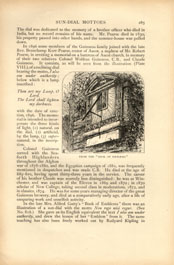
[Full Image]
FROM THE "BOOK OF EMBLEMS."
The dial was dedicated to the memory of a brother officer who died in India, but no record remains of his name. Mr. Pearse died in 1830, his property passed into other hands, and the summer-house was pulled down. In 1896 some members of the Guinness family joined with the late Rev. Beauchamp Kerr-Pearse, rector of Ascot, a nephew of Mr. Robert Pearse, in erecting a memorial on a buttress of Ascot church, in memory of their two relatives Colonel Wolfran Guinness, C. B., and Claude Guinness. It consists, as will be seen from the illustration (Plate VIII.), of a reclining dial bearing the motto, I also am under authority; below which is a lamp inscribed: Thou are my Lamp, O Lord. with the date of erection, 1896. The memorial is intended to incorporate the three kinds of light, (1) natural, on the dial, (2) artificial, by the lamp, (3) super-natural, in the inscription. Colonel Guinness served with the Seaforth Highlanders throughout the Afghan war of 1878-1880, and the Egyptian campaign of 1882, was frequently mentioned in despatches and was made C. B. He died at the age of fifty-five, having spent thirty-three years in the service. The career of his brother Claude was scarcely less distinguished: he was at Winchester, and was captain of the Eleven in 1869 and 1870; in 1870 scholar of New College, taking second class in moderations, 1872, and in classics, 1874. He was for some years managing director of the great Guinness brewery, and died at a comparatively early age, after a life of unsparing work and unselfish activity. In the late Mrs. Alfred Gatty's "Book of Emblems" there was an illustration of a sun-dial with the motto Non rego nisi regar. (See No. 816.) She gave as its English equivalent the text I also am under authority, and drew the lesson of her "Emblem" from it. The same teaching has also been finely worked out by Rudyard Kipling in |
"McAndrews' Hymn" where he leads the old Scotch engineer who had lost the thread of his childhood's faith to find it again amid the throbbing notes of his engine hammers: "True beat, full power, the clangin'chorus goes |
|
| 451. |
I AM A SHADE, A SHADOW TOO ART THOU: At the Manor House, Chew Magna, Somerset. The lines are also to be found in "Vignettes in Rhyme," by Austin Dobson. |
| 452. | I AM A SHADOW, SO ART THOU: Inscribed on a dial in the Grey Friars churchyard, Stirling; and in 1884 placed on West Lodge, Carthorpe, Yorkshire. (With No. 464.) |
| 453. | I COUNT NONE BUT SUNNY HOURS. Erected 1863. Dial in the Fort, Delhi. |
| 454. | I COUNT THE BRIGHT HOURS ONLY. At Portway Hall, near Oldbury. On a fine dial engraved in 1898 by F. Barker and Son, London, for the Skinners' Almshouses, and inscribed: "Presented to the Skinners' Almshouses, Palmer's Green, by Henry Luke Hansard, Esq., Master 1893-4." The Arms of the Skinners' Company and the motto, TO GOD ONLY BE ALL GLORY, are also on the plate. A slightly different version was on Prince Albert Victor's dial. See No. 1306. |
| 455. | I COUNT THE SUNNY HOURS. On a dial recently erected on the house of Capt. Hart, Grove Lane, Handsworth. |
| 456. | I GIVE MEN WARNING HOW THE HOURS FLY, At Esher Place, Surrey, the seat of Sir Edgar Vincent, K. C. M. G. – "Country Life," Jan. 6, 1900. |
|
EYAM CHURCH. (See No. 511, page 295) |
ASCOTT CHURCH. (See No. 450, page 285) |
To face page 286.
| 457. |
I MARK NOT THE HOURS UNLESS THEY BE BRIGHT, These lines, with No. 813, are engraved upon the pedestal of a dial in the garden of Downham Hall, Norfolk, together with the following inscription: "Taken from a gun battery on Kelbouroun Spit, at the entrance of the Dneiper, captured by the English and French on Oct. 17th, 1855, being the first fort and portion of territory of Russia proper taken by the allied forces in the war of 1854-55." The dial is of slate and was presented to the Duchess of Cleveland, who at one time owned Downham Hall and was erected on a stone pedestal and inscribed by her orders. |
| 458. | I MARK ONLY THE SUNNY HOURS. On a window dial for a south aspect, which was exhibited at a bazaar in Crathie, and purchased, it is believed, for the Queen. Round the dial face was a view in Siena, and below it the inscription: "This dyal was fashioned by Oscar Patterson. The same being vitrarius and glass painter inne Glasgowe, shewinge the tyme in this tovne." I MARK NONE BUT SUNNY HOURS is at Bournestream House, Wotten-under-Edge. The date of the house is 1614. |
| 459. | I MARK THE MOMENTS TROD FOR GOOD OR ILL. At the Priory, Warwick, with the initials T. H. and date 1556. The date, however, is that of the house, the dial being modern. |
| 460. | I MARK TIME, DOST THOU? On a pedestal dial in the garden of Cubbington Vicarage, co. Warwick, erected in 1847. Also on the south gable of Elmhurst, Rugby, erected by Mr. Hunter, the owner. The dial-face is supported by graceful figures of Night and Day in low relief; the former is shrouded in a mantle, the latter holds a bird on her finger. |
| 461. | I NOTE THE BRIGHT HOURS OF DAY. Over the entrance door of Copthorne Hall, Shrewsbury. |
| 462. | I NUMBER NONE BUT SUNNY HOURS. At Galtfaenen, North Wales. |
| 463. | I ONLY MARK BRIGHT HOURS. A horizontal dial, mounted on a square stone pedestal, which stands in the gardens of Kiplin Hall, Yorkshire, bears this motto. It was |
| inscribed and erected by the late Countess of Tyrconnel. The motto is also on a vertical dial at Messrs. Barker's works, No. 12, Clerkenwell Road, London. | |
| 464. |
I SPEAK NOT, YET ALL UNDERSTAND ME WELL, These lines, Dean Alford's paraphrase of No. 1139, were placed, with No. 452, on a vertical dial on West Lodge farmhouse, near Carthorpe, Yorkshire, in 1885, by the late G. J. Serjeantson, Esq, |
| 465. |
I STAND AMID YE SUMMERE FLOWERS Sent to Mrs. Gatty in 1860 for her collection, by her friend the Rev. Greville J. Chester, as being inscribed on the four sides of a dial in the garden at S. Windleham. It was an ingenious practical joke, as the motto was invented for the occasion, but the lines were so pretty and quaint that she was loath to let them pass away unrecorded. |
| 466. | I STAY FOR NO MAN. On a house at Colley Weston, Northants. |
| 467. | I WISH THE SUN WOULD SHINE, ON ALL MEN'S FRUITS AND FLOWERS, AS WELL AS MINE. In the Earl of Crawford's garden at Balcarres, Fife, there is an ancient pillar dial with many faces cut upon its sides. It has been mounted on a base of four steps, and the motto is carved on the lowest of them. |
| 468. | ICH DIEN. I serve. On a dial in the garden at Menwith Hill, Darley, Yorkshire, with Nos. 1147, 1530. |
| 469. | ICH ZAEHLE NUR DIE HEITERN STUNDEN. I count the bright hours only. On an iron octagonal dial, 13 inches diameter, made by Moellingen, Berlin. |
| 470. | ICH ZEIGE NUR DIE HEITERN STUNDEN. I show the bright hours only. In the Zoological Gardens, Berlin. |
| 471. | ICI FRAPPE À TOUTE HEURE. Striking here at all hours. Over the door of a blacksmith's forge at Réaumont (Isère). |
| 472. |
ICI TU VERRAS L'HEURE, On a house opposite the Cemetery at St. Savin (Isère). |
| 473. |
IF MY MASTER USE ME WELL On a small brass ring dial in the Exeter Museum. |
| 474. |
IF O'ER THE DIAL GLIDES A SHADE, REDEEM These lines were written by the Rev. R. W. Essington, and inscribed on a dial in the form of a cross, which he placed on a pillar in Shenstone Churchyard, near Lichfield, in 1848. The pillar had previously borne a dial-plate of simple form, but this had been lost. Mr. Essington also erected a cross-dial in the garden of Shenstone Vicarage, with No. 1263 as a motto, and both were copied from a cross-dial at Highlands, near Calne, Wilts. After leaving Shenstone Mr. Essington went to live at Plen, Newquay, Cornwall, where he has placed a cross-dial in front of his house, inscribed with a slightly different version of the lines above. See No. 1369. A cross-dial bearing Mr. Essington's lines (No. 474) was made and presented to the Museum Gardens at Lichfield, by Mr. Hopcraft, stone-mason in the city. The same lines, with slight verbal alterations, are on a beautiful little white marble cross-dial, mounted on a red sandstone pillar, which was placed over a child's grave in the churchyard of North Collaton, Devon, about the year 1857. |
| 475. | IGNOTUM TIME. Fear the unknown. With Nos. 862, 980, in the Passage du Petit St. Antoine, Paris. |
| 476. |
IL EST PLUS TARD QUE JEUNESSE NE PENSE, Youth doth not think how fast the moments fly, On a circular vertical dial at Pelvoux (Hautes Alpes). |
| 477. |
IL EST PLUS TARD QUE TU NE PENSE, Formerly in the Faubourg St. Antoine, Paris. The first line is on a house on the roadside between Valbonne and the Grande Chartreuse; and on the churches at Roche and St. Savin (Isère). |
| 478. | IL EST PLUS TARD QUE VOUS NE CROYEZ. 1851. Z. G. F. It is later than you think. At Abriès (Hautes Alpes). |
| 479. | IL (F)AUT (ÉVITER LA RE)TARD. We must not be late. In an old courtyard, Rue Contrescarpe, Paris. In 1883 the motto was almost obliterated, but the missing letters were supplied by Baron de Rivière. |
| 480. | IL FAUT PARTIR TÔT OU TARD, Sooner or later all must go. Formerly on the Bureau des Messageries, Rue Contrescarpe, Paris. It was the place whence the mails and diligences used to start, so the double meaning of the motto is evident. |
| 481. | IL LUIT POUR TOUT LE MONDE. It shines for all the world. See No. 541. In 1864 this motto was, with the picture of the sun, on the sign of an inn at Viviers. Above the door was written: "Aujourd'hui comptant, demain credit!" |
| 482. |
In the court of the Evêché, Angoulême. |
| 483. |
On a church wall at Campitello, in the Italian Tyrol. |
| 484. |
Dean Burgon, writing to "The Guardian," February 26th, 1874, an account of the ancient inscriptions at Ravenna, concluded his letter with the above lines, copied from a sun-dial on the façade of the church of |
| St. Apollinare in Classe, and which, after wandering over the scenes of vanished greatness around the old city, struck him as possessing peculiar interest."After traversing," he says, "for miles the level plain outside Ravenna, and noting with interest the heaps of flat, rounded pebbles, alternating with heaps of detritus from the Bosco – which record the nature of the change which has passed over the entire aspect of the country – the humble words inscribed on this sun-dial struck me very forcibly."The motto is now entirely effaced. | |
| 485. | IL TEMPO FUGGE ANCHE AI SOLLECITI. Time, even to the careworn, flies apace. On the Palazzo del Marchese Scalzi, Via dei Servi, Florence. |
| 486. | IL TEMPO FUGGE E NON S'ARRESTA UN ORA. Time flies and stays not an hour. On Casa Bacci, in the Piazza at San Marcello Pistoiese, Italy. The line is slightly altered from that of Petrarch: "La vita fugge e non s'arresta un ora.' |
| 487. | IL TEMPO PASSA, E L'ETERNITÀ S'AVVICINA. Time passes away, eternity draws near. With No. 790 on a dial at Riva, Val Sesia, dated 1829. |
| 488. | IL TRAVAILLE TOUJOURS, MÉNAGERS, IMITEZ LE. It works without ceasing; labourers, follow its example. On the farmhouse of St. Barnabé, near Sillans (Var). |
| 489. | ILLE EGO SUM, LONGUM QUI METIOR ANNUM, I am he that measures the length of the years, that seeth all things; – through whom the earth seeth all things; the eye of the universe. On a white freestone dial, inserted in the gable of an Early English porch at Wootton Church, Oxon, with the initials and date as follows: "R. H., 1623, J R. Ch. Wa." The motto is taken and altered from Ovid's "Metamorphoses": "Ille ego sum, dixit, qui longum metior annum, |
| 490. | ILLUMINAT UMBRA. He gives light with a shadow. At a village on the Lake of Como, copied 1897. |
| 491. | ILLUSTRAT ET URIT. He gives light, and burns. Formerly in the Cour du St. Esprit, Paris. |
| 492. | IMITONS LE, TRAVAILLONS SANS RELÂCHE. Let us imitate (the sun); let us work unceasingly. At Quinsons (Basses Alpes). |
| 493. | IMMINET MORS. Death is upon thee. Formerly in the convent garden of the Petits Augustins, Paris. |
| 494. | IMMOTUS VERTO. Without moving, I turn. At Sylve Bénite (Isère). |
| 495. |
Given in "Notizie Gnomoniche." |
| 496. |
IMPROVE THE PRESENT HOUR, FOR ALL BESIDE Copied by Juliana H. Ewing from a dial on a wooden pedestal, shaped like a nine-pin, which stood in the garden of Rose Cottage, Fredericton, New Brunswick, in 1867. Mrs. Shore, who then owned the house, was a great friend of Mrs. Ewing, and frequently mentioned in the latter's letters. In October, 1867, she wrote to Mrs. Gatty: "I have got you a dial, and mean to make you a sketch and send it herewith. It is in the garden of a little old lady here, Mrs. Shore. She is very tiny and very old. She goes to the 7.30 Service like clockwork, has a garden, paints life-sized portraits in oils!! and complains that, 'between housekeeping, literature, and the fine arts, she never has time for anything."A grandson of Mrs. Shore, R. Pennefather, Esq., has written recently about the dial from Sinzig am Rhein, as follows: "When my mother and I last went out to Canada, she missed the sun- dial, though the pedestal was still standing. The house (Rose Cottage) had been let to various people, and we supposed it had been 'annexed.' One day, Mother wanted some horse-radish, and, as that newly laid down in the garden was not yet large enough for use, I volunteered to try to dig for some, having noticed some leaves like that behind an old stable the year before. I dug down about 2 or 3 feet before I got a good thick piece of root, and threw up an old silver button with the Fleur-de-lys on it. (The house was the oldest in the town, and had been the original Governor's when Fredericton was an old French post under Louis le Grand.) Of course, that set me grubbing away, and what should come to light? The plate of the sun-dial mentioned above. The gnomon, or style, was missing, but the plate now lies on the table before me. It was made for par. 46, but evidently of English workmanship. The date is 1826. I do not know whether it was put up by my great-grandfather, old Chief Justice Saunders, or by his widow. He raised a troop of hussars at the breaking out of the 'War of Independence,' and fought for the King all through the war. He was given large tracts of land in New Brunswick to replace |
| his estates in Maryland, etc., confiscated by the rebels. The old house is no more. The railway passes right over the site, and all the old carved butternut mantel-pieces, doorways, etc., have passed away in smoke, and all I have left of the old home is a photograph and the sun-dial." | |
| 497. | IMPROVE THE TIME. 1765. On an oval dial on the Unicorn Inn at Uppingham; and on Market Harborough Church, dated 1850. |
| 498. | IN COELO QUIES. 1793. In heaven is rest. On a vertical dial affixed to the wall of Glaisdale Church, Yorkshire. |
| 499. |
IN HIS OWN IMAGE THE CREATOR MADE, Written by Walter Savage Landor as a motto for a dial, but it is not known whether it has been adopted. |
| 500. |
IN HORA NULLA MORA. In the Rectory garden at Micheldean. See No. 354. |
| 501. | IN LUCEM OMNIA VANA. All things are vanity (when brought) into the light. At Biella-alta, in Piedmont; and on a house at Ville Vallouise. See No. 133. |
| 502. | IN OMNIBUS REBUS RESPICE FINEM. In all things look to the end. This line, from Thomas À Kempis, was inscribed on a pedestal-dial in the garden of Crowder House, Ecclesfield, Yorkshire, by the late Bernard Wake, Esq., the owner. The house formerly belonged to a yeoman family named Wilkinson, who had held the land for more than four hundred years, one Julyan Wilkinson, of Crowder House, being named in an existing deed which bears the date 1402. |
| 503. | IN REASON'S EYE THY SEDENTARY SHADOW TRAVELS HARD. 1819. On a dial which once stood at Port Elphinstone, Aberdeenshire, but is now at Ardkeen, Inverness. |
| 504. | IN SUCH AN HOUR AS YE LOOK NOT FOR, THE SON OF MAN COMETH. 1793. Was on a plain oval dial on the south porch of Bakewell Church, |
|
ON THE PORCH OF BAKEWELL CHURCH 1793 |
IN YE CLOISTER GARDEN WINCHESTER COLLEGE |
Derbyshire, but when last heard of, in 1888, the motto was nearly obliterated. |
|
| 505. |
IN SUCH AN HOUR AS YE THINK NOT THE SON OF MAN COMETH.
This inscription, from St. Matt. xxiv. 44, was found nearly effaced on the dial which was removed from the parish church of Wakefield, Yorkshire, in 1881, during repairs. That it was not the first sun-dial on the church is shown by the Churchwardens' accounts: 1592. The dyall in the Churchyard was sett up. |
| 506. |
IN THE HOURE OF DEATHE GOD BE MERCIFUL UNTO ME. In front of Stanwardine Hall, near Baschurch, Shropshire, a fine old Elizabethan mansion, now converted into a farmhouse, stands a pillar-dial, having a silver plate, on which these and other inscriptions are engraved. The dial is circular and horizontal, drawn in a square; and the four vacant corners of the square are occupied by the above two couplets we have given; and below, on one side, by an elephant with a castle on his back; and in the opposite corner is a squirrel sitting up and |
| eating. In the centre of the plate there is a stanza of four lines (see No. 375), and beneath is a bird on a shield, with the date, "anno 1560." Stanwardine Hall belonged to the Corbet family, from which it passed to the Wynnes, and it is now in other hands. The elephant and squirrel are the Corbet crests. | |
| 507. | IN UMBRA DESI In shadow I cease. Seen on the picture of a dial in a scrap-book at Florence. |
| 508. |
IN UNA SI MUORE. On a restaurant at Beaulieu, near Nice. |
| 509. |
INCESSANT DOWN THE STREAM OF TIME On a horizontal dial with stone pedestal in the kitchen garden at Lansdowne Lodge, Kenmare, co. Kerry. "Time is a river or violent torrent of things coming into being; each one, as soon as it has appeared, is swept off, and disappears, and is succeeded by another which is swept away in its turn. : – Meditations of Marcus Aurelius Antoninus. |
| 510. |
INDEX VT VMBRAS SIC TVOS IESV REGIS. 1635.
As the gnomon rules the shadows, so dost Thou, O Jesu, rule thine own. These lines are given in Hunter's"South Yorkshire" as having been "formerly on a piece of marble fixed over a gate," near Darfield Church, Yorkshire. They can hardly have belonged to anything but a sun-dial. The capitals are chronograms, and can be transposed so as to form the date 1635 in each line. |
| 511. | INDUCE ANIMUM SAPIENTEM. 1775. Take to thyself a wise mind. May be seen on the south porch of the church at Eyam, Derbyshire. The place is renowned for a terrible visitation of the Plague which nearly depopulated it in 1666; still more so for the gallant conduct of its rector, the Rev. William Mompesson, who, with his wife, remained at home tending the sick, burying the dead, and inducing his people to keep within their narrow valley, so that the disease spread no further. Mr. Mompesson lived through the visitation, but his wife and 258 other people died. See Plate VIII., p. 286. The dial is very elaborate, and has the tropics of Cancer and Capricorn marked upon it; also the names of various places, showing their difference from English time, and "Wm Lee, Thos Froggatt, Church Wardens." The face has recently been restored, and the further motto Ut hora sic vita, added below. |
| 512. | INSTAR GLOBI STAT MACHINA MUNDI. Like a ball stands the framework of the world. At Moccas Court. See No. 1469. |
| 513. | INSTAT FORTE SUPREMA. Perchance the last hour is drawing near. In the kitchen garden of the former convent of the Célestins, Paris. |
| 514. | INTRA ET ADORA SOLEM QUI NON FACIT OCCASUM. Enter, and worship the Sun which setteth not. Above the church door at Villedieu (Cantal). |
| 515. | INTUS APOLLO SOL EXTRA. Apollo within, the Sun outside.
Motto proposed for a sun-dial on the Théatre Favart. |
| 516. | INVENI SORTEM, SPES ET FORTUNA VALETE, I have found my destiny, farewell hope and fortune, Baron de Rivière tells us that a public official who had retired to a county house near Béziers, after long buffeting with men and circumstances, to enjoy the delights of home and literary pursuits, inscribed this motto on a dial which he placed in front of his house. |
| 517. | IO PASSA COMME L'OMBRA. I pass away like the shadow. In the Hameau de la Maladière, near Rives (Isère). |
| 518. | IO SEGNO L'ORA E TU RAMMENTE IDDIO. I mark the hour and do thou think upon God. In the Cloister of the Convent of Santa Sabina, Rome. |
| 519. |
At the Villino Vanwiller, Milan. |
| 520. | IO TI DO L'ORA, SE IL SOL RISPLENDE. I give the hour, if the sun shines. In the Val Mastallone; contributed to "Notes and Queries" (6th S., xi. 45). |
| 521. |
Copied in 1860 from a house in the Rue de France, Nice. The dial was traced in brown on a white-washed wall. The late Dean Alford translated the motto as follows: "I come and go and go and come each day; In 1880 the dial was repainted, and the last part of the motto altered thus: Ma tu se vai più non ritorni. This new rendering was, in 1888, becoming illegible, owing to the effects of weather upon the thin coating of plaster on which the words were painted, and the original motto could be discerned below. The dial was first set up in 1830. The same motto has been read at Arma di Taggia; and at Pisa. It is also inscribed on a dial which stands in the Italian garden of the Manor House, Monkton Farleigh, Wilts. This dial was erected by Mr. Wade Browne, a tenant of the manor (1842-57), in memory of his younger brother, who was killed in the Kaffir war. Of this motto on a dial in a Riviera garden, E. V. B. writes: "The music of the words still seems to haunt the soul in opal tinted dreams, whose colour somehow does not fade with the fading lights of other days." – A Garden of Pleasure. |
| 522. | IPSE SUO CURSU VIRTUTEM MONSTRAT ETHORAS. Himself in his course showeth both virtue and the hour. On an altitude dial in Mr. Evans'collection, which seems to have been made in commemoration of a friendship between Corbin, the Abbot of Scheyern, and Martin, the Prior of Indersdorf (or Undersdorf), in Bavaria. The Dial is engraved on a gilt brass plate, and elaborately adorned with various emblematical devices. At the top is the sun's face, with arrows for rays, and crowned with a bishop's mitre; possibly this is a portrait of Abbot Corbin, to whom the dial was presented. The motto is on a scroll above the sun. In each corner of the plate there is a flaming heart bearing numerals, as if it were a dial, and transfixed with an arrow for a gnomon. Above these hearts are the following lines: "His magis Vndenses flammis augentur Amoris; By these flames, O men of Undersdorf, Love is evermore increased; |
Along the base of the plate is the couplet: "Pectora sunt Augustini, sunt tela Sebasti, The hearts are those of Augustine, the darts (arrows) those of
Sebastian, In the centre of the plate there is a building resembling the front of a Greek temple, with arrows as pillars, and a hole at the apex for the gnomon. On this is written: "Horas designat simul ac demonstrat amorem idem Index." The pointer indicates at the same time the hours and love. The back of the plate is engraved for printing universal dials, and this is also elaborately decorated. In place of the "temple" there is a double lyre, over which two pastoral staves are joined in a ring. Two mitres, a sheaf of arrows, and the hilt of a sword also appear, but the "bow of Martin" is not given on either side. Perhaps the presence of arrows presupposes the bow. There is an inscription written on enfolded scrolls in such a fashion that it is difficult to tell in what order the words are meant to follow: "Abbatis Schirẽst Prepos: Vnderst Horologa Concordiæ Bicithera quam Gemino Natali R. Rrum et Amplissim: Corbini Martini Præsulum Germanorũq fratrũ Nouẽdiali festo paravit pulsavit obsequiosa manus." Mr. Evans suggests that the meaning of this may be somewhat as follows: The dial of love in the shape of a double lyre which a dutiful hand made and struck (as a lyre) for the double birthday of the Abbot of Scheyern Corbin, and the Prior of Indersdorf Martin, very reverent and important chiefs of the German Brothers, on their nine day festival. It does not seem quite clear whether the "festival" was actually the day on which the friends were born, or the festival of their patron saints. At the base of the lyre where the staves unite in the ring is inscribed: "Obliget æternis fraters hic annulis annis." |
|
| 523. | IRREPARABILE TEMPUS. Time cannot be retrieved. At the Certosa dei Calci, near Pisa. |
| 524. | IRREVOCABILE. (Time) cannot be recalled. On Little Milton Vicarage, Oxon; and also with No. 114 on a vertical dial lately fixed on a new wing at Holmhurst, Sussex, by Mr. A. J. C. Hare. |
| 525. | IRREVOCABILIS HORA, 1842. The hour that cannot be recalled. Copied in 1860 from the toll house on the Pont du Siagne, near |
| Cannes. The dial was vertical and painted in white on a yellow wall, and over the door were the words, "logement du garde du pont." The motto was also read in the same year, roughly written, and mis-spelt, with date 1850, on a south dial over the door of a shed in the Vallée de Gourdalon, two miles from Cannes. | |
| 526. |
This motto was written by the Rev. S. E. Bartleet. It is identical with No. 852, though the lines have been altered in arrangement. The verse has been inscribed by Messrs. Barker and Sons on a dial made by them for a house at Cawley Wood, Essex. The English rendering was written by Sir Herbert Maxwell and printed in "Blackwood's Magazine," 1891. |
| 527. |
This was read somewhere in Tuscany. |
| 528. |
IT IS A LIGHT THING FOR THE SHADOW TO GO DOWN TEN DEGREES; With No. 1647 on an elaborate dial erected in 1840 in the gardens of Bredisholm, near Glasgow. The quotation is from 2 Kings, xx. 10. |
| 529. | ITA VITA. Such is life. At Porchère (Basses Alpes); and also on a dial represented in one of Bewick's illustrations to "Æsop's Fables." |
| 530. |
ITALICUM SIGNAT TEMPORA SACRA DEO. An Italian (dial) shows times sacred to God. The inscription states that in the thirteenth year of the pontificate |
of Gregory XVI., Giovanni Antonio Teppati restored and embellished this dial, by the order of Antonio Matteucci, clerk of the works of the church of the Vatican. The dial is a large horizontal one of white marble placed on the balustrade which surrounds the roof of the nave of St. Peter's at Rome. It tells the hours from X to XXII, following the old Italian method by which the twenty-four hours are counted from the ringing of Ave Maria, half an hour after sunset. This dial, and its companion, No. 342, placed on the corresponding corner of the balustrade, are remarkable from their position, standing as they do at more than a hundred and fifty feet above the ground. Probably no other dials in the world have been raised so high. Their use is, however undeniable. The roof of St. Peter's is a village in itself."There are," says Mr. Wey, "workshops, huts, sheds for domestic beasts, a forge and carpenter's stores, washhouses, ovens. For several families it is a native land. The workmen of St. Peter's, called San Pietrini, succeed one another from father to son, and form a tribe. The natives of the terrace have laws and customs of their own," and as it appears, their timekeepers also. The hours are marked in Roman numerals. The motto, probably, refers to the Italian hours, which are shown on this dial as the ordinary ones are on its fellow. It recalls a saying suggested by the sight of a clock on a northern cathedral: "I was thinking," said I, "why it was that men placed clocks in the towers of churches." "That is easily answered, man; to teach you that Time is a sacred thing."("Old Church Clock".) |
|
| 531. |
ITQUE REDITQUE VIAM CONSTANS QUAM SUSPICIS UMBRA, Goes and returns the shade in its unerring track, Given in "Notizie Gnomoniche." |
| 532. | JAM INCLINATA EST HORA. The hour is now far spent. This motto is written on an illustration in a French MS. on dials in the possession of Lewis Evans, Esq. The MS. appears to have been written at Nancy in the first half of the eighteenth century. |
| 533. |
On a house near Newton House Woods, near Whitby. The first line is above, the second below the dial face. They are from Ovid, Rem. Amor. 93, 94. See Nos. 1043, 1601. |
